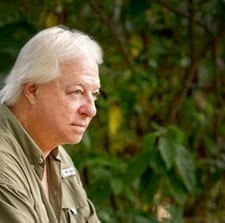From Butter Churns to Bats
July 13, 2017By Tom Poland
She kept the old churn in the kitchen. I see it vividly, even now. I watched my Grandmother Poland churn butter, a memory that sure seems old-fashioned in this digital age. I have no idea who made that churn. It vanished with the years, nowhere to be found, but I can tell you this much: baseball bats and butter churns share a connection.
For me, this story begins in Apex, North Carolina where I was visiting my daughter and her family the weekend of June 10. The occasion was my grandson’s graduation from high school. Just before I headed back, my daughter gave me my Father’s Day gift a week early, the odd bat you see with this column. It’s a Louisville Slugger that didn’t pass quality control. I never gave much thought to how bats are made but this bat sent me on a quest to learn more and along the way I discovered a surprise.

Here’s what I learned. Round, 37-inch blanks, or billets, are shipped to the Hillerich & Bradsby Co., factory in Louisville, Kentucky. There a tracer lathe turns them, guided by a metal template. Templates correspond to the specifications of each pro player. The bats are then fire-branded with the Louisville Slugger mark that goes on the flat of the wood’s grain, where the bat is weakest. Players know to swing with the label facing either up or down, so they can strike the ball with the edge grain. That’s where the bat is strongest. Hit the ball on the flat grain and more often than not the bat breaks.
Finishing up, the bats get dipped into one of several possible water-based “finishes” or varnishes. That gives them their color and protective coat. Each player chooses the finish they desire, while some players, former Kansas City Royals star George Brett comes to mind, leave their bats unfinished.
My surprise? I learned about the connection between butter churns and bats. In the 1880s 17-year-old John A. “Bud” Hillerich was working at his father’s woodworking shop in Louisville Kentucky. The story goes that Bud, a big baseball fan, skipped work one afternoon in 1884 to watch Louisville’s major league team, the Louisville Eclipse, play. Bud watched as the team’s star, Pete Browning, mired in a hitting slump, broke his bat.
Bud invited Browning to his father’s shop and offered to make him a new bat. Following Browning’s suggestions, Bud did just that. The next day Browning used the bat and ended his slump with three hits. Browning’s nickname? The Louisville Slugger.
Browning told his teammates about his new bat, and players descended on Hillerich’s shop. Bud’s father, however, had no interest in making bats. To him the future would be built around stair railings, porch columns, and butter churns so he turned away ball players. Bud, however, clung to his vision and eventually persuaded his dad to make baseball bats.
In 1894, Bud Hillerich took the business over from his father, and registered the name “Louisville Slugger” with the U.S. Patent Office. In the early 1900s, the company set a sports marketing precedence by paying Hall of Fame hitter Honus Wagner, the Flying Dutchman, to use his name on a bat. By 1923, Louisville Slugger outsold all other bat makers in the country. When Bud Hillerich made that bat for Pete Browning, he set big things into motion. Legends like Babe Ruth, Ty Cobb, and Lou Gehrig all swung Louisville Sluggers—the number one bat of what purists claim is the country’s number one sport.
Louisville Slugger would go on to sell more than 100,000,000 bats, making it the most popular bat brand in baseball history. Part of the credit goes to Frank Bradsby who joined the company in 1911. Bradsby, a successful salesman for one of the Hillerich’s largest buyers, joined J.F. Hillerich and Son, bringing professional sales and marketing expertise to the operation. In 1916, he became a full partner, and the company changed its name to Hillerich & Bradsby Co.
Take me out to the ball game … and the battlefield. During World War II the company made M-1 carbine gunstocks, track pins for tanks, and billy clubs for the armed forces. The years rolled by and in time a corporate entity came calling. In 2015, Wilson Sporting Goods bought the Louisville Slugger brand from Hillerich & Bradsby Co., which still owns Louisville Slugger Museum & Factory and the production facility. H&B keeps making Louisville Slugger bats exclusively for Wilson in Louisville, Kentucky. Flawed bats don’t get scrapped. Some end up as Father’s Day gifts. My daughter got me the bat you see here at the museum. Pretty smart move to sell rejects as souvenirs.
No missing the museum, by the way. A colossal bat, 120-feet long, the world’s largest, towers over the building. Made of steel, it weighs 68,000 pounds and it’s an exact-scale replica of Babe Ruth’s 34-inch Louisville Slugger bat.
From butter churns to bats, it’s quite a story. Did the Hillerichs make my grandmother’s old churn? I doubt it. But thanks to my daughter, Beth, you know how Louisville sluggers came to be, how they’re made, why bats break, and their connection with old churns.
Visit Tom Poland’s website at www.tompoland.net
Email Tom about most anything. tompol@earthlink.net
Tom Poland is the author of twelve books and more than 1,000 magazine features. A Southern writer, his work has appeared in magazines throughout the South. The University of South Carolina Press released his book, Georgialina, A Southland As We Knew It, in November 2015 and his and Robert Clark’s Reflections Of South Carolina, Vol. II in 2014. The History Press of Charleston published Classic Carolina Road Trips From Columbia in 2014. He writes a weekly column for newspapers in Georgia and South Carolina about the South, its people, traditions, lifestyle, and changing culture and speaks often to groups across South Carolina and Georgia, “Georgialina.”














